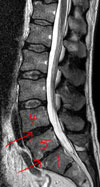|
|||
(1) Medical History
Questions are given about symptoms and how problem is affecting daily activities. Your doctor will also want to know what positions or activities make your symptoms worse or better.
(2) Physical Examination
Doctors check your posture and the amount of movement to see which back movements cause pain or other symptoms. Your skin sensation, muscle strength, and reflexes are also tested.
(3) Diagnostic Tests:
X-ray: can show if one or more discs has started to collapse. It can also show if there are bone spurs in the vertebrae and facet joints which are small points of bone that form with degeneration.
Discography: a specialized X-ray test in which dye is injected into one or more discs. The dye is seen on X-ray and can give some information about the health of the disc or discs. This test may be done when the surgeon is considering surgery, since it can help determine which disc is causing the symptoms.
MRI: it is helpful for showing if the tissues in the disc are able to absorb water and whether there are cracks inside the disc. It can also show if there are problems in other soft tissues, such as the spinal nerves.

